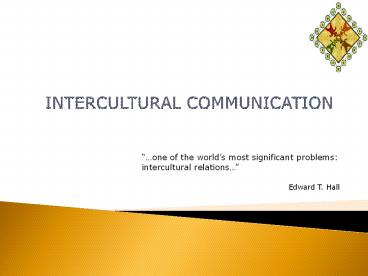intercultural communication - PowerPoint PPT Presentation
Title:
intercultural communication
Description:
intercultural communication – PowerPoint PPT presentation
Number of Views:866
Title: intercultural communication
1
INTERCULTURAL COMMUNICATION
one of the worlds most significant problems
intercultural relations
Edward
T. Hall
2
OUTLINE OF TODAYS LECTURE
- 1. The Nature of Intercultural Communication
- 2. Dominant Cultural Orientations
- 3. Domains of Cultural Differences
- 4. Steps Towards Effective Communication
3
PART ITHE NATURE OF INTERCULTURAL COMMUNICATION
4
DEFINITION
- Intercultural communication is
- communication between at least two people from
different cultures.
5
WHY STUDYINTERCULTURAL COMMUNICATION?
- Increasing interaction between people due to
- globalization
- Increasing diversity in workplaces
- Increasing need to develop caring, responsible
and - ethical business leaders
6
DEFINITION OF CULTURE
- What is culture in
- intercultural communication?
7
FUNDAMENTAL CHARACTERISTICS OF CULTURE
8
INTERCULTURAL DOMAINS
- National cultures
- Social groups
- Ethnic groups
- Genders
- Age or generational groups
- (and more)
9
IMPLICATIONS
- If intercultural communication is communication
between at least two people from different
cultures - ALL communication between people is essentially
intercultural. - Different types of cultures shape communication.
- Caring, responsible and ethical business leaders
must be effective intercultural communicators.
10
PART IIDOMINANT CULTURAL ORIENTATIONS
11
CULTURAL ORIENTATIONS
- How contexting affects communication
12
CULTURAL ORIENTATIONS
- How face-saving affects communication
13
CULTURAL ORIENTATIONS
- How the individual is viewed in relation to the
group
14
CULTURAL ORIENTATIONS
- How time is perceived
15
CULTURAL ORIENTATIONS
- How power is distributed
16
CULTURAL ORIENTATIONS
- How decisions are made
17
CULTURAL ORIENTATIONS
- Reminder cultural orientations are NOT
dichotomies they are tendencies.
18
PART IIIDOMAINS OF CULTURAL DIFFERENCES
19
DOMAINS Verbal
- Choice of words
- Organization of messages
20
DOMAINS Non-verbal
- Body language
- Eye contact
- Laughter
- Touch
- Tone, volume and speed
- Turn-taking and silence
21
- PART IV
- STEP TOWARDS EFFECTIVE COMMUNICATION
22
STEPS TOWARDS EFFECTIVE COMMUNICATION
- Develop a sense of cultural awareness
- Do not be ethnocentric
- Listen genuinely when others speak
23
STEPS TOWARDS EFFECTIVE COMMUNICATION
- Do not lapse into your own language while in the
presence of others who do not speak it - Take responsibility for the communication (e.g.,
if miscommunication happens, it is not always the
other persons fault) - DO NOT STEREOTYPE
24
CONCLUSION
- Intercultural communication
- respects people as part of a group and as
- individuals.
- is not about interaction between national
cultures - only.
25
CONCLUSION
- Intercultural competence
- helps you deliver your messages clearly,
- appropriately and persuasively.
- enables you, as a business leader, to
contribute to - a just and equitable world.
26
- THANK YOU!
- Q A































